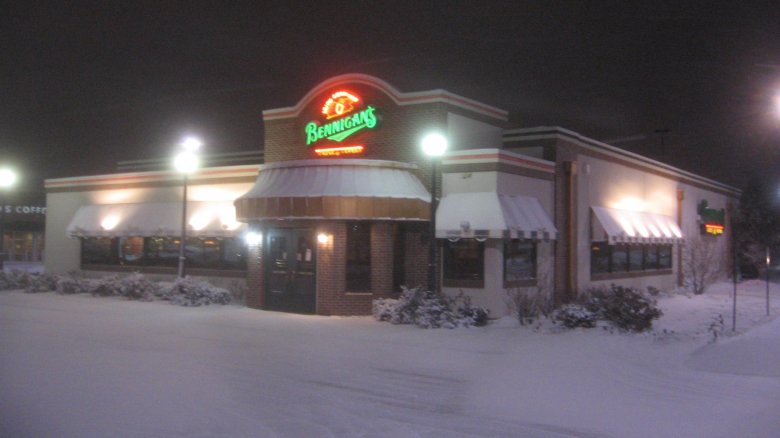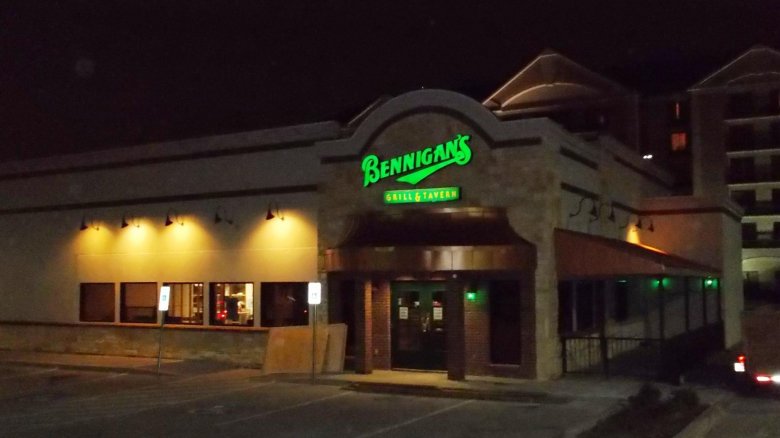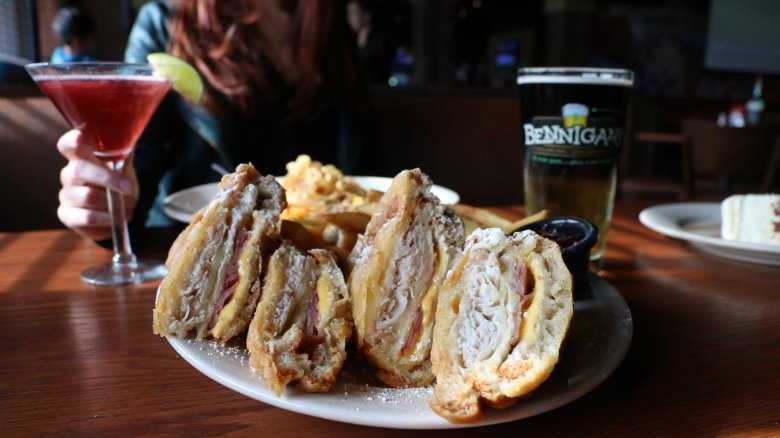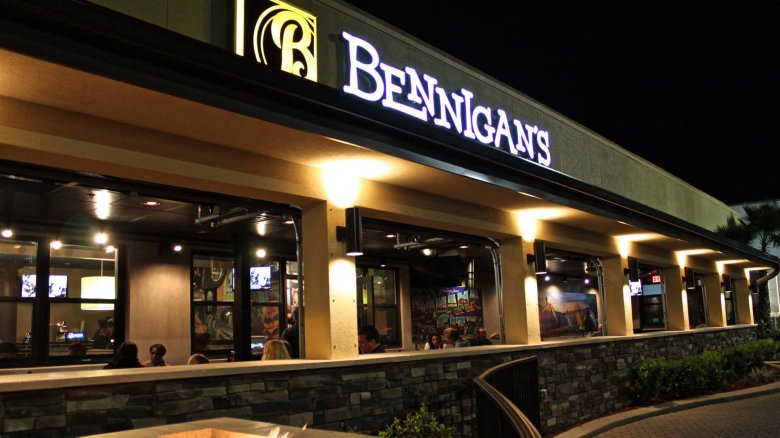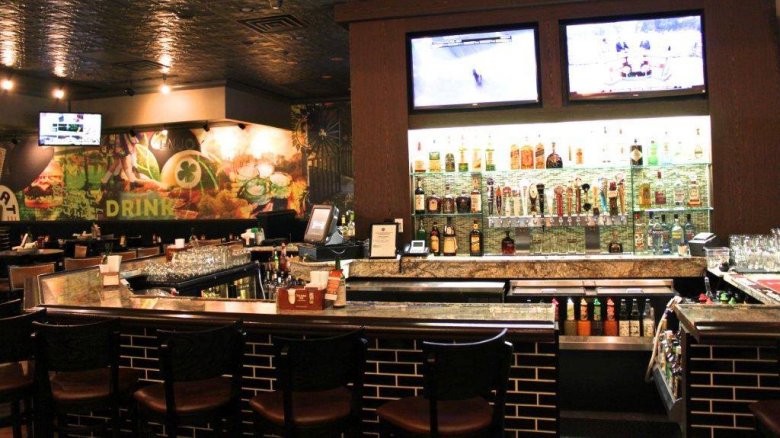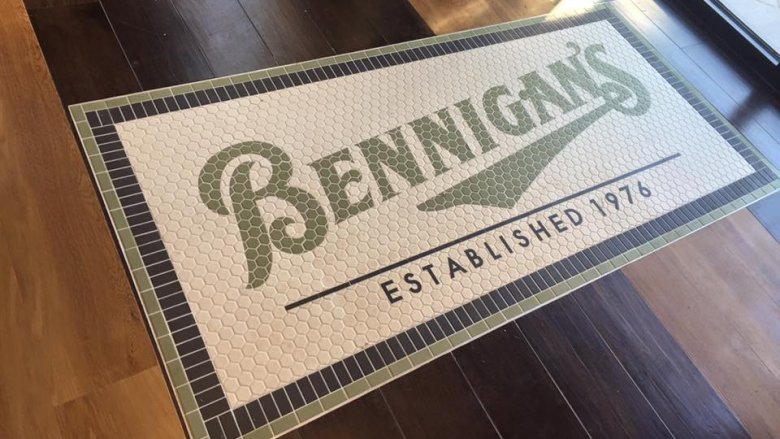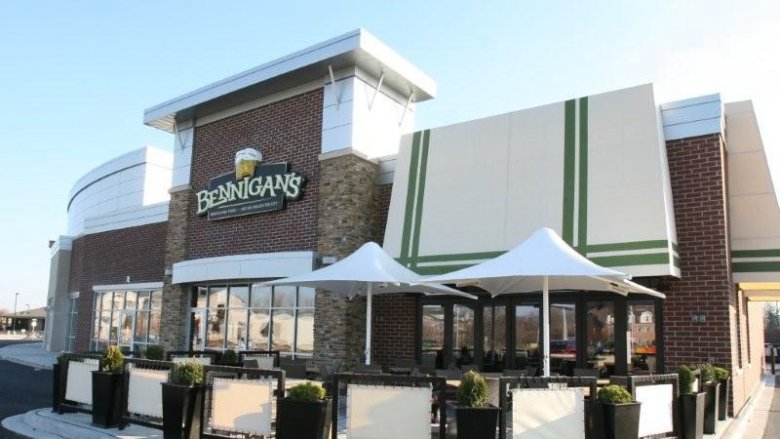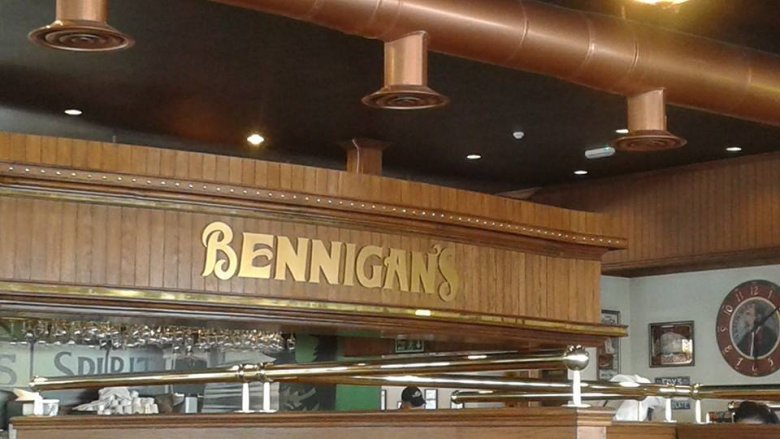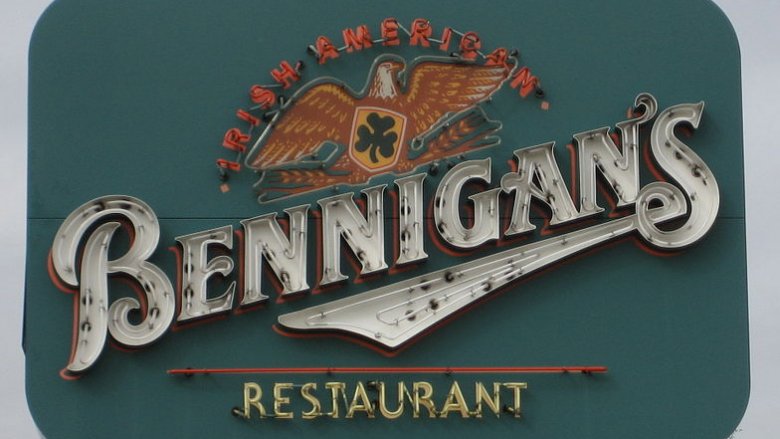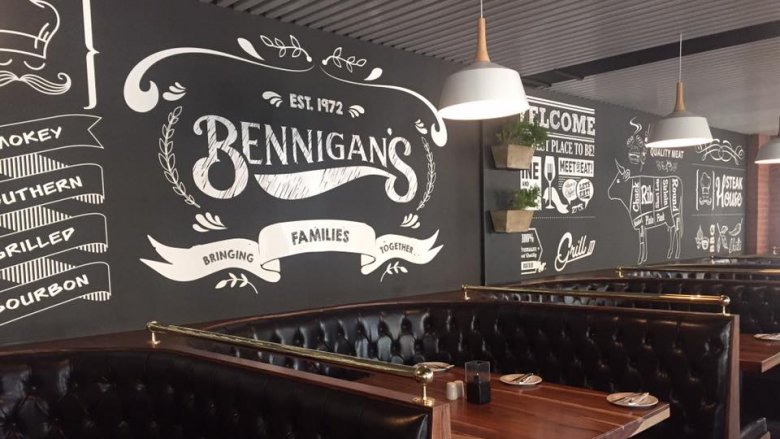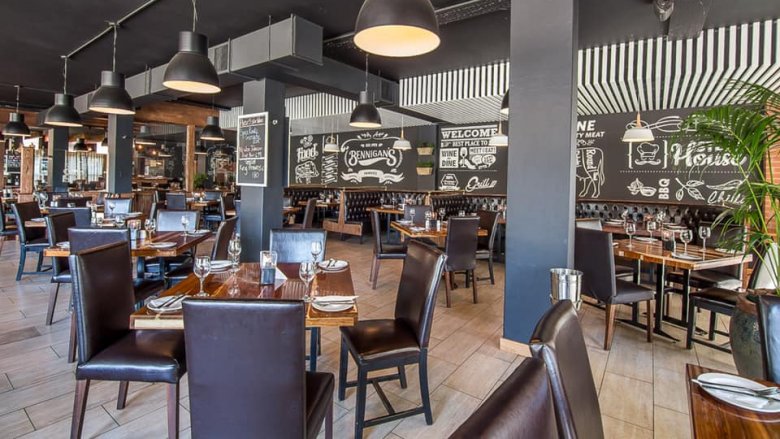The Real Reason Bennigan's Restaurants Disappeared Across The Country
The Irish-themed, pub-crawl-ready but still family-friendly casual dining chain Bennigan's was at the top of its game at the turn of the century. Famous for great happy hour deals and waiters who wore "flair," the chain started in Atlanta in 1976, and was a hit as both an after-work haunt and a special occasion Sunday dinner. But like many casual family dining establishments this century, it has had some major hurdles to overcome. At one point the chain had around 300 restaurants. By 2008, it had to close several hundred of them after declaring Chapter 7 bankruptcy. By 2011, the chain's sales for the year were more than half a billion dollars less than its heyday in 2001. And by December of 2012, only 33 stores remained — and those numbers weren't done shrinking.
What sent the Irish-American fusion of a chain to the brink? Why was a restaurant that had become a suburban staple all of a sudden closing locations at a drastic rate? While Bennigan's has been steadily making a comeback, there are some legit factors that contributed to why it disappeared so rapidly — to the point of near extinction. These are the real reasons why Bennigan's almost vanished.
The Bennigan's brand lost its meaning
There's really not a more eloquent way to put this: Bennigan's stopped being cool. The brand didn't adapt to the standards of newer generations of restaurant goers. The time leading up to its lowest point in 2008 should have been spent trying to adapt to the contemporary breed of restaurant that started to arise at the time, the new and trendy fast-casuals like Chipotle and Panera were much more popular among young people, and Bennigan's — a restaurant that was a favorite of their parents — did nothing to win those young customers back.
But perhaps Bennigan's also failed to maintain its own brand in a way that reminded customers why they liked the chain in the first place. Current CEO Paul Mangiamele was hired as part of the efforts to revive the chain in 2011. He told Restaurant Business, "They lost the brand DNA. They lost the culture... the insidious disease called brand drift." Bennigan's was going to have to reestablish its value in order to survive. "When you lose your vibe, you're not worth saving," he added. "Bennigan's never lost its vibe. It lost its scale."
Bennigan's food was no longer what people preferred
Bennigan's might have been doomed as the 2000s progressed, when consumers started obsessing over the idea of eating fresh, organic, local, and sustainable. "Artisan" is a culinary buzzword that started gaining popularity (and losing it's meaning) around that time too. Giant portions of fried items like one would find at Bennigan's wasn't what folks were craving, and definitely it wasn't considered artisan. There just wasn't a big enough market anymore to pick up what Bennigan's was putting down.
The country was starting to get more health conscious too, so the calorie explosions that were Bennigan's signature menu items — we're looking at you Death by Chocolate and Monte Cristo — definitely weren't making the grade. Bar food like fried steak was not something the majority of health-savvy Americans were eyeing for dinner at the time. The National Restaurant Association facilitated a survey in 2007 that revealed (via Newsweek) that 76 percent of adults in the U.S. acknowledged more of an effort to find healthier options at restaurants than they did two years prior. If Bennigan's had developed at least some healthier or more trendy menu items at the time, maybe it would have maintained some of its fan base.
The hospitality at Bennigan's went downhill
A lot of restaurant experts thought one of Bennigan's shortcomings was a decline in good service. Food took longer to arrive and the facilities themselves needed an upgrade. If the entire establishment seems dated across the board, it's certainly not going to lure in new customers, and it's bound to tick off any returning ones. While Olive Garden was busy living up to their "when you're here, you're family," mantra, the Bennigan's brand sort of got lost in shuffle. It's like people were asking themselves, "Why did we like Bennigan's again?" They lost a sense of connection to to the chain and as a result, there were less bums in seats at the neighborhood's faux Irish pub.
As restaurant expert and author Bill Marvin told Newsweek in 2008 in the wake of Bennigan's bankruptcy, "It's [Bennigan's] just one more place to eat... the thing that's been missing in the hospitality business is hospitality." If they were going to survive, Bennigan's needed to go above and beyond to make customers feel serviced and special again.
Americans were spending less money at places like Bennigan's
When people were having to pinch pennies to afford gas during the Great Recession, the occasions to enjoy a big meal out at the local family chain were few and far between. When money is tight, sometimes the first luxury to go is eating out, especially if the food seems overpriced.
Consumers just weren't spending as much going out to eat at restaurants like Bennigan's. Not only were times lean, but when folks did spend, it was usually on healthier cuisine — not only was locally-grown and produced food healthier, but often, it was cheaper. The all-you-can eat platters of brands like Bennigan's just weren't something people were plunking down there for coin for at the time. Higher food and fuel costs meant people were driving less, and eating less opulently.
Americans being less gluttonous was a benefit to hearts and wallets, but definitely a detriment to Bennigan's bottom line.
The competition with so many similar chains was too much for Bennigan's
By 2008, the competition for the honor of most popular casual dining family chain had gotten real stiff, and Bennigan's did not come out on top in this contest for customers. Massive chains had expanded so quickly that diners had a difficult time deciphering what was what — is there really a difference between Chili's, Applebee's, TGI Friday's, and Bennigan's? So if a person got a craving for old-school casual dining, they would usually just go to the cheapest one, as restaurants reduced their prices to try and attract customers. If price wasn't a factor, they went with the one advertising the best looking limited-time offering. Unfortunately for Bennigan's, that was usually someone else on both counts.
When reflecting on the Bennigan's fall out and the slow demise of other casual dining chains at the time, Ron Paul, the president of Technomic (a food service consulting firm) in 2008, told CSP Daily News, "To some extent, they've become victims of their own success — a mature category with too many units and not enough differentiation, at least in the eyes of consumers." Like a lot of similar chains at the time, it's possible Bennigan's got lost in the sea of giant portions and teams of waiters singing signature restaurant birthday songs.
Bennigan's wasn't a great option in an increasingly convenience-driven culture
With the emergence of technology, everything has gotten a whole lot more convenient, from getting a ride somewhere to changing a flight, which can all be done through a few taps on your phone. So it's not a surprise that as technology started to make our overall day to day existence more convenient, people wanted their food to be convenient too. They wanted to find restaurant locations, browse the menu, and maybe even order ahead — all from their phones. It's something we've come to expect in this high tech, everything-at-your-fingertips world we live in, and Bennigan's just didn't offer that. In fact, the Bennigan's app didn't appear until 2018, well after most other casual dining chains had filled up our screens with endless possibilities.
If diners did go to a family casual chain, it was for a special occasion, not because they impulsively decided they were hungry. More options became available for those who wanted food and wanted it quick. Why sit down for a long meal at Bennigan's when you can quickly order at Chipotle and have that grub in your hot little hands less than 10 minutes after arriving (depending on the lines)? More convenience-driven options definitely contributed to less peeps frequenting Bennigan's.
Bennigan's struggled to stay afloat during the Great Recession
When the economy started to weaken in the beginning of what we now call the Great Recession at the end 2007, a lot of restaurants suffered due to the higher costs associated with fuel, food and labor. The more expensive operating overhead was just one of Bennigan's issues at the time. If the chain isn't faring well for a number of reasons, and to top it off the cost of food goes up? That's not a good combo for the business's bottom line.
"Ron Gorodesky, a consultant for Paoli, Pa.-based Restaurant Advisory Services, explained to Newsweek, "If you're already not doing terribly well, and your revenues take a 10 percent hit, and your food costs go up 15 to 20 percent, it has a tremendous impact on your bottom line."
Darren Tristano, the vice president of food service consulting firm for Techonomic, told USA Today in 2012, "The economy's been a big negative for these restaurants trying to gain traction or even grow, and so in many cases they've actually just continued to struggle and close units that were underperforming." A lot of businesses suffered in this economic downturn and Bennigan's was no exception.
Bennigan's ultimately filed for Chapter 7 bankruptcy
In July of 2008, Bennigan's hit rock bottom. Its parent company, S&A Restaurant Corp, which ran several other entities including Steak & Ale restaurants, filed for Chapter 7 bankruptcy. Almost immediately, 150 of Bennigan's corporate units subsequently closed. The franchised restaurants (138 of them) hung on a little longer but that number eventually shrank to 70. The fact that it was Chapter 7, and not Chapter 11, signifies just how bad it had gotten. Chapter 11 bankruptcy protection lets companies restructure while not having to answer to creditors just yet. Chapter 7 bankruptcy liquidates all assets. It means that the company is so in debt, they can't continue operations.
Bennigan's bankruptcy and abrupt closures represented a significant blow to the American chain restaurant. What was once considered a powerhouse went downhill fast, so a lot of industry insiders were genuinely questioning the fate of similar establishments after Bennigan's went down. The news of Bennigan's bankruptcy is probably why so many customers assumed it was a goner — because in most places, it was.
Thankfully, Bennigan's is making a comeback
The same year S&A Restaurant Copr, Bennigan's parent company declared Chapter 7 bankruptcy, Atalaya Capital Management bought Bennigan's out of said bankruptcy. Investors then hired Paul Mangiamele, a long-time restaurant business veteran, to revive the once thriving family chain. Mangiamele ended up buying the chain outright in 2015, and in 2018, they opened three restaurants in Texas, Ohio, and North Dakota, and experienced record-breaking numbers. The restaurants aren't nearly as large as the original Bennigan's but are getting double the amount of customers. It's has made its mark in some international markets too.
Paul Mangiamele, in the wake of the new restaurants' success in 2018, told Restaurant News, "Bennigan's has reignited the emotional connection that has existed with fans for more than half a century... we pioneered casual dining and when our guests discover that Bennigan's is back, they become enthusiastic ambassadors for the brand. That's what tells me that even after another strong year of growth in 2018, our brightest days are still ahead." It seems like Bennigan's has officially been revived from the dead, or is reaping some serious benefits for people's penchant for nostalgia these days.
Bennigan's is now focusing on much smaller markets
Part of Bennigan's comeback strategy has been focusing on smaller markets. Both land and rent are cheaper. Rather then setting up shop in larger metropolitan centers and working its way out to the 'burbs, Bennigan's is focusing on smaller markets, hence the 2018 openings in Steubenvile, Ohio; Monahans, Texas; and Mandan, North Dakota.
Small towns are also just more appreciative. As Bennigan's CEO Paul Mangiamele explains on the Bennigan's website, "If I open a Bennigan's in Manhattan, it's ho-hum, another restaurant... you open in Monahans, Texas, and it's the biggest event of the century." Since the Bennigan's in small cities becomes the "main event," so to speak, there is also less reliance on having other businesses attached to drive in customers. In other words: the Bennigan's spots in these cities don't have to be part of a "lifestyle center" to survive and thrive.
It's also easier to start in smaller markets for hiring purposes. Bennigan's becomes a desirable employer in these towns, and, in turn, Bennigan's doesn't have to compete with the demands of big city workplace culture, i.e. more demands for flexible scheduling and other incentives. In places where the job market has been bleak, restaurant employees are eager to earn the money and work for a well-reputed establishment. I
If Bennigan's continues to succeed with this tactic, pretty soon people will be driving out of the city to go out to eat. And this longtime American chain will continue to serve up American grub with "Irish hospitality."
